35 days. It was the longest shutdown in government history, which came to an end only after our political leaders came to a temporary agreement.
The irony? The shutdown ended up costing the U.S. economy much more than the amount President Donald Trump requested for his boarder wall – the source of the original disagreement and the conflict that fueled the shutdown.
The shutdown began Dec. 22, 2018, after Congress and the president could not agree on $5 billion in funding for a boarder wall between the U.S. and Mexico. Trump wanted the wall, and Congress refused to fund it.
Then, in 2019, Democrats took over the House of Representatives and the new Speaker of the House, Nancy Pelosi, took Trump on, refusing to budge or compromise on border wall funding.
This standstill lasted 35 long days. Flights were delayed. Families evicted. Government workers furloughed or forced to work without pay.
Finally, an agreement was struck to open the government for three weeks and continue negotiations during that time, but not before leaving a disaster in its wake.
Reports show that federal contracts for 1,150 government-funded properties that house low-income renters expired as a result of the shutdown. This delayed repairs and even caused some families to be evicted. This represented 5% of all Section 8 programs.
In fact, the Federal Housing Administration called on all approved mortgagees and lenders to be “sensitive to the financial hardships experienced by borrowers as a result of the shutdown,” including borrowers who were subject to furlough, layoff, or a reduction in income due to the shutdown.
The more than 800,000 government workers who didn’t receive pay during that time were paid back, but many were forced to take out loans or dip into savings during their month without pay, and it could take a while for them to recover. Also, government contract workers will not receive back pay since they didn’t work during that time – they just lost their contract work.
“President Trump’s historic, 35-day shutdown of the federal government has had a deeply harmful impact on millions of Americans and the U.S. economy,” Chairwoman of the House Financial Services Committee Maxine Waters, D-Calif., said. “While this shutdown recently came to an end, we must not forget the recovery has just begun for a wide range of affected consumers, including federal employees, contractors, small businesses and other individuals.”
 “Many of those people will not receive back pay, and many of them have various financial obligations, like a mortgage or a student loan payment, that they may have missed,” Waters said in a floor statement on H. Res. 77, a resolution to encourage financial institutions, consumer reporting agencies and other entities to do what they can to help individuals affected by the shutdown. “However, they did not cause the shutdown and should not suffer any negative consequences from it.”
“Many of those people will not receive back pay, and many of them have various financial obligations, like a mortgage or a student loan payment, that they may have missed,” Waters said in a floor statement on H. Res. 77, a resolution to encourage financial institutions, consumer reporting agencies and other entities to do what they can to help individuals affected by the shutdown. “However, they did not cause the shutdown and should not suffer any negative consequences from it.”
The National Association of Realtors reported that 11% of its members said they had transactional delays as a result of the shutdown. Another 11% said they had customers opt out of buying or selling their home until the uncertainty clears.
Many Americans may also see delays in receiving their tax returns. While Trump said that Americans will get their money, and quickly, a government watchdog warned that the Internal Revenue Service is backed up.
The National Taxpayer Advocate, a government watchdog group that oversees the tax collector, said it could take 12 to 18 months for the IRS to catch up, saying it is buried in millions of unanswered taxpayer letters and is weeks behind schedule for training and hiring new workers for the tax season.
Now, as the dust is beginning to settle, we’re getting our first look at the cost of the shutdown on the economy.
The cost
A new report from the Congressional Budget Office shows that the shutdown likely cost the country $11 billion in economic activity.
The CBO estimates that the country’s gross domestic product will likely be down by $3 billion for the fourth quarter of 2018 compared to what it would have been had the government not shut down at the end of the year.
But given that the government shut down toward the end of December, the greater impact will be felt in the first quarter of this year. The level of real GDP is expected to be $8 billion lower in the first quarter than it would have been if the government was open for business, according to the CBO.
 A new report from S&P Global Ratings suggests a similar downturn in economic activity as a result of the shutdown. S&P’s report showed the U.S. economy lost at least $6 billion dollars because of the shutdown.
A new report from S&P Global Ratings suggests a similar downturn in economic activity as a result of the shutdown. S&P’s report showed the U.S. economy lost at least $6 billion dollars because of the shutdown.
This is more than the $5.7 billion that the White House requested for the border wall that was the central cause of the shutdown itself.
“The longest partial shutdown in history, which started as a minor cold, began to feel like a nasty flu that had begun to spread across the states,” S&P said in its report. “And the overall cost is likely worse than what we had previously expected.”
While the CBO notes that some of the lost economic activity will likely be regained in future quarters, the CBO and S&P write that some of what was lost during the shutdown may never be recovered.
“Among those who experienced the largest and most direct negative effects are federal workers who faced delayed compensation and private-sector entities that lost business,” the CBO said. “Some of those private-sector entities will never recoup that lost income.”
S&P agrees, noting that some of the direct costs from the shutdown are unrecoverable.
“In particular, economic activity from lost productivity from furloughed government and contract employees won’t be recovered. The direct hit to economic activity from furloughed workers is amplified by lost spending by furloughed government and contract workers due to lack of ready income,” S&P notes. “Furloughed contract workers will not get back pay, so they are left trying to repair finances after losing five weeks of wages.”
The CBO also notes that there are some other consequences that will not likely be felt immediately, but will begin to show themselves in time.
“For example, some businesses could not obtain federal permits and certifications, and others faced reduced access to loans provided by the federal government,” the CBO wrote. “Such factors were probably beginning to lead firms to postpone investment and hiring decisions.”
“In addition, risks to the economy were becoming increasingly significant as the shutdown continued,” the CBO added. “Although their precise effects on economic output are uncertain, the negative effects of such factors would have become increasingly important if the partial shutdown had extended beyond five weeks.”
S&P also notes that the shutdown may have lasting consequences on the government employees and contractors who were basically turned into pawns in what turned out to be a pointless political standoff.
“We did not consider the effect on morale of government workers who were required to work without pay,” S&P said. “Even if they decided to show up to work, some, reportedly, have called in sick, we suspect that working in those conditions has lowered productivity rates for them as well.”
“It may also create a challenge for government agencies and contractors, when they want to hire them back,” S&P continued. “With worries that Uncle Sam may leave them in the lurch, with bills to pay, the next time the government decides to close, which is all too frequent, these workers may decide to opt for a job in another industry that they feel has more job security.”
And with more potential shutdowns looming, those negative effects could come sooner rather than later.
“Although this shutdown has ended, little agreement on Capitol Hill will likely weigh on business confidence and financial market sentiments,” S&P said. “For those workers who were living without a paycheck, revolving credit payments and credit scores may also take a hit. Although this funding battle has ended, the next one starts in a few weeks, which may reduce growth expectations if businesses and financial markets begin to expect that Congress and the president will repeat the experience again and again.”
Future shutdowns
Lawmakers came to a temporary agreement to re-open government, but they are far from a permanent agreement. Pelosi continues to insist there will be no border wall funding, and Trump says he will find a way to get the funding.
“If we don’t get a good deal from Congress, the government will either shut down again on February 15th, or I will use the powers afforded to me by the Constitution of the United States to secure the funding,” Trump said when he announced the temporary deal to reopen the government.
Shutdowns have been increasing in number. During this administration, the government shut down not once, not twice, but three times as the president and Congress were constantly at odds over funding issues.
Previously, the government shutdown in January 2018 also due to immigration-related issues – protections for young people in the Deferred Action for Childhood Arrivals program, an Obama-era program that shields young undocumented immigrants from deportation. Congressional Democrats wanted to give them certain protections, Trump did not.
And now, with the track record on this administration, some economists are beginning to project what yet another government shutdown could mean for the economy.
 “The partial government shutdown had concentrated effects, with limited ramifications for the broader U.S. economy,” Moody’s explained in a report. “A second shutdown could be more severe.”
“The partial government shutdown had concentrated effects, with limited ramifications for the broader U.S. economy,” Moody’s explained in a report. “A second shutdown could be more severe.”
Moody’s found that the damages from the most recent shutdown “have been concentrated with limited ramifications for the broader economy.” However, that would change if another shutdown happened again soon, as it would “complicate negotiations over the debt ceiling,” sparking fears about whether the Treasury Department would delay debt payments.
And economic struggles aren’t the only thing the administration has to fear as a result of another shutdown. Government employees are also becoming increasingly put off by the insecurity their job offers.
Government workers who spoke to TIME over the course of the shutdown about the challenges of not receiving pay say they are worried about the precariousness of their situation and are increasingly angry about their jobs being on the line because of the budget battles.
Keeping good workers, or hiring new ones, might increasingly become a problem for government offices.
The housing industry responds
Once the government was reopened, the housing industry responded by commending the government for coming to a short-term agreement, explaining the effects the shutdown had on housing, and pressing lawmakers to pass longer-term funding.
“NAHB commends President Trump and congressional leaders for working together to reopen the government for three weeks while they tackle the issue of border security,” said Randy Noel, National Association of Home Builders chairman. “At a time when the nation is facing a growing housing affordability crisis, the shutdown has exacerbated the situation by disrupting funding for important HUD housing programs.”
“It is vitally important that Congress and the White House come to an agreement on securing our southern border to ensure the federal government remains open indefinitely,” Noel said.
NAR said that while the shutdown did not have a direct effect on real estate, the economic uncertainty it caused did.
“The housing industry was already facing market challenges before any government closure,” NAR Chief Economist Lawrence Yun said. “A home purchase is a major expenditure that simultaneously involves a high level of excitement and anxiety, and the shutdown adds another layer of unnecessary complication to the home buying process.”
“It is causing tangible harm to potential buyers, the real estate market, and economic growth,” he said.
Yun estimates that the economy will see a drop of 0.5 percentage points directly related to the shutdown, saying, “The longer the shutdown, the more impact from it.”
The National Low Income Housing Coalition called the shutdown “a disgrace.”
“The shutdown was a disgrace, causing stress and hardship for our country’s lowest-income and most vulnerable people,” NLIHC President and CEO Diane Yentel said. “Over time, we will learn the extent of the longer-term damage done to the programs that serve them and to what extent the damage can be remedied.”
Some in the industry simply expressed their hope that this would not happen again.
“As it has become abundantly clear in recent weeks, the shutdown has had a real impact on borrowers and our industry,” said Nate Shultz, The Money Source vice president of government and regulatory affairs, on the day the government reopened. “Hopefully, today’s developments will lead to a lasting compromise that will ensure critical federal programs remain up and running without further incident.”





